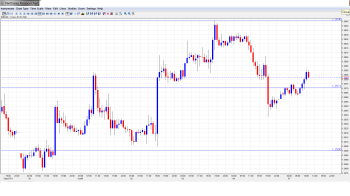EUR/USD has edged higher in Monday trading. In the European session, the pair is trading slightly below the 1.36 level. The US government shutdown continues, with no indications of any progress towards a resolution of the crisis. Monday has a very light schedule, with just three releases to start off the week. In the Eurozone, Sentix Investor Confidence fell in September and was well below the estimate. Eurozone GDP rebounded nicely, posting its first gain in 2013. In the US, today’s sole release is Consumer Credit.
Here is a quick update on the technical situation, indicators, and market sentiment that moves euro/dollar.
EUR/USD Technical
- In the Asian session, EUR/USD was steady, trading close to the 1.3570 line. The pair has edged upwards in the European session.
- Current range: 1.3570 to 1.3650.
Further levels in both directions:
- Below: 1.3570, 1.3500, 1.3460, 1.3415, 1.3325, 1.3240, 1.3175, 1.31, 1.3050 and 1.3000.
- Above: 1.3650, 1.3710, 1.3800, 1.3870 and 1.3940.
- 1.3570 continues to see activity and is a weak support line. 1.3500 follows.
- 1.3650 is providing resistance.
EUR/USD Fundamentals
- 8:30 Eurozone Sentix Confidence. Exp. 10.9, Actual 6.1 points.
- 9:00 Eurozone Final GDP. Exp. 0.3%, Actual 0.3%.
- 19:00 US Consumer Credit. Exp. 12.6B.
* All times are GMT.
For more events and lines, see the Euro to dollar forecast.
EUR/USD Sentiment
- US shutdown drags on: The US government shutdown is almost a week old, and there is no progress to report out of Washington. Democrats and Republicans have dug their trenches, and each side is blaming the other for the impasse. Republicans had demanded that the Democrats delay implementation of the 2010 health care act known as Obamacare before agreeing to pass a budget. The Democrats have refused, saying the budget must first be passed before any discussions can be held. There are growing concerns that a prolonged shutdown will hurt the US economy. If the shutdown does continue, we could see some instability in the markets this week, and the US dollar, which is already under strong pressure, could lose ground.
- Debt ceiling crisis next? The headlines and news programs are focused on the current shutdown, which has paralyzed the US government for close to a week. However, a far more serious crisis is lying just around the corner – the debt ceiling. The US has a debt worth $16.7 trillion, and will run out of funds to service the debt by October 17, unless Congress authorizes raising the debt ceiling. Otherwise, the US could potentially default on its obligations, which could cause chaos in the domestic and international markets. Republican House Speaker John Boehner seems to have hardened his position, saying on the weekend that the Republicans would not raise the debt ceiling without a “serious
conversation” about what is driving the debt to such high levels. - QE tapering unlikely in 2013: There was a lot of expectation that the Federal Reserve would taper QE in September, and most analysts were caught by surprise when the Fed opted not to reduce the bond-buying program. However, things have changed dramatically in the past few weeks, with the budget deadlock in Washington and fears about a debt ceiling crisis. Even if both of these issues are resolved tomorrow, the distortions and delays in key economic data will make it difficult for the Fed to have an accurate, up-to-date picture of the US economy. This was underscored on Friday, as Non-Farm Payrolls, a key gauge of the labor market, was cancelled due to the shutdown. So in all likelihood, we won’t see a tapering of QE in the next few months.
- Low growth, low inflation, low rates for Eurozone: As expected, the ECB maintained its key interest rate at 0.50% earlier last week. There was more interest in the follow-up press conference, where ECB President Draghi downplayed risks to the fragile Eurozone economy, and repeated that interest rates would remain at current or lower levels for an “extended period of time” given the low growth levels and weak inflation in the Eurozone. Friday’s PPI releases underscored the lack of inflation in the Eurozone, as German PPI declined by 0.1%, while Eurozone PPI dropped to a flat 0.0%. With little growth and low inflation, there’s little room for interest rates to go anywhere but down.

